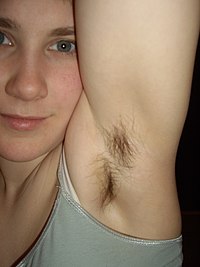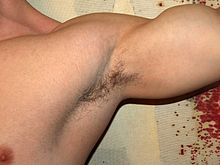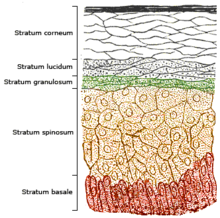Axilla
![]()
This article is about the area between the shoulder and the chest wall; for other meanings, see Axilla (disambiguation).
In human anatomy, the armpit (Latin axilla) refers to the area between the shoulder and the chest wall. In a narrower sense, however, the axilla means the axillary fossa (axillary fossa), although it should be noted that the anatomical definition of the axilla does not correspond to the colloquial term either. The axillary fossa in anatomy is the space under the shoulder bounded in front by the anterior axillary fold formed by the pectoralis major muscle, in back by the posterior axillary fold formed by the dorsalis major muscle, and inward by the rib cage, while lying under the skin. The colloquial term of the axilla, on the other hand, means only the skin fold between the chest wall and the upper arm, i.e. the skin of the axillary fossa.
As a rule, the armpits are hairy from puberty onwards. In various cultures, however, armpit hair is considered unaesthetic and is therefore removed by the wearer (see also section "Cultural aspects" in the article "Body hair").
In the armpit there are many sweat and sebaceous glands (axillary glands), such as the apocrine sweat glands (glandulae sudoriferae apocrinae), which enable an increased emission of sexual attractants (pheromones) through the armpit hair (see also vomeronasal organ). By means of a deodorant (deodorant for short, also deodorant), which is mainly applied in the armpits, body odor can be suppressed and/or the activity of the eccrine sweat glands can be inhibited (see antiperspirant). The skin glands can be responsible for various diseases, including underarm wetness and carbuncles. The axillary lymph nodes are located under the skin.
Body temperature is often measured in the armpit with a fever thermometer (axillary temperature measurement) to diagnose possible fever, even though this method is particularly inaccurate compared to rectal or oral measurement.
Axillary blockade is a regional anesthesia procedure that allows surgical procedures to be performed on the arm.

Axilla of a woman

axilla
Anatomy of the axilla
axillary fossa
When the upper arm is abducted (spread), the axillary fossa forms a four-sided pyramid, the spatial extent of which is approximately as follows:
| Base: | axillary fascia |
| ventral (anterior) wall: | Fascia clavipectoralis, Musculus pectoralis major, Musculus pectoralis minor |
| dorsal (back) wall: | Musculus subscapularis, Musculus latissimus dorsi, Musculus teres major |
| medial (towards the middle of the body) wall: | anterior serratus |
| lateral (outer) edges: | anterior and posterior axillary folds (formed by the pectoralis major and latissimus dorsi muscles) |
| cranial (upper) wall: | Shoulder joint (articulatio humeri), proximal end of humerus, coracobrachialis muscle and caput breve of biceps brachii muscle |
| Tip: | midclavicle |
· 
Superficial muscle layer of thorax and upper arm, right side viewed dorsally
· 
The branches of the brachialartery
· 
The veins in the right axilla, seen ventrally
· 
The right brachial plexus (the infraclavicular part), view from the front below
· 
The left side of the chest
·
Axilla
·
Axilla
·
Axilla
·
Axilla
·
Axilla
·
Axilla
·
Axilla
Axle gaps
Since the space between the teres major and teres minor muscles is divided by the long head of the triceps, this creates two gaps called the lateral axillary foramen (lateral axial gap) and the medial axillary foramen (medial axial gap). Through the quadrangular lateral axillary foramen pass the axillary nerve, which innervates the deltoid muscle and the overlying skin, and the posterior circumflex humeral artery; through the triangular medial axillary foramen pass the circumflex scapular artery.
Physiological microbiome of the axilla
In general - here in the area of the human axilla - the microbiome refers in a broader sense to the totality of all microorganisms colonizing the human body. In a narrower sense, this refers to the totality of all microbial genes or genomes (DNA) in the human organism and is distinguished from the term microbiota, which refers to all microorganisms.
In a rough overview, the human skin can be divided into three zones: oily, moist and dry regions. Oily skin, i.e. rich in sebaceous glands, is found between the eyebrows, next to the nose, on the back of the head, on the chest and on the upper back. Moist regions are found at the entrance to the nose, under the armpits, in the bend of the elbow, in the hollow of the knee, on the sole of the foot, in the navel or in the fold of the buttocks. Dry regions include the skin on the buttocks, palms and forearms.
One of the earliest investigations of the microbiota in the axillae was published by James Leyden et al. (1981). In bacterial cultures of more than 200 women and men examined, members of the bacterial family Micrococcaceae and representatives of the bacterial genera Corynebacterium and Propionibacterium were detected.
Jackman and Noble (1983) examined the bacterial composition of the axillae of 163 male and 122 female subjects and were able to show that aerobic bacteria of the genus Corynebacterium spp. predominated in a large proportion of the men, while the axillary bacterial flora of both women was dominated by Micrococcaceae.
Patrick Zeeuwen et al. (2012) were able to show in their experimental set-up (injured vs. regenerating skin) that the actual microbiome of the skin is not located on the surface of the horny layer (stratum corneum) but in the deeper layers of the cornea underneath and that there is not only a different microbial composition of the uppermost horny layer of normal healthy skin with those in deeper skin layers of the skin in the individual individuals, but that there were also clear differences in the composition of the microbiome between women and men. Thus, strikingly, they also found bacteria from the genital area in the deeper skin layers (bacteria from the vulva and vagina in women and bacteria from the penis in men), although only in small numbers.

Cell layers of human epidermis
Search within the encyclopedia






